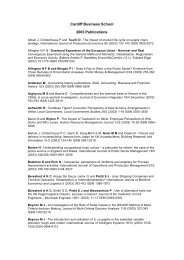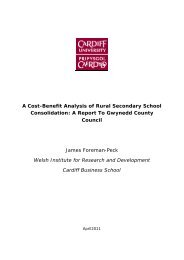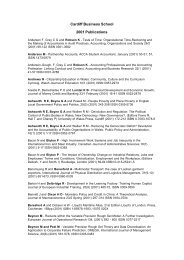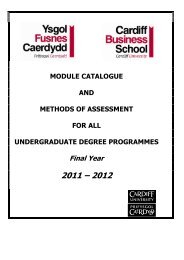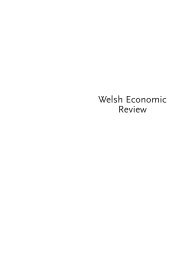Revisiting the Great Moderation using the Method of Indirect Inference
Revisiting the Great Moderation using the Method of Indirect Inference
Revisiting the Great Moderation using the Method of Indirect Inference
You also want an ePaper? Increase the reach of your titles
YUMPU automatically turns print PDFs into web optimized ePapers that Google loves.
Table 2: Calibration <strong>of</strong> Parameters<br />
Parameters Denitions Calibrated Values<br />
time discount factor 0.99<br />
inverse <strong>of</strong> intertemporal consumption elasticity 2<br />
inverse <strong>of</strong> labour elasticity 3<br />
! Calvo contract price non-adjusting probability 0.53<br />
G<br />
steady-state gov. expenditure to output ratio 0.23<br />
Y<br />
steady-state output to consumption ratio 16 1 (implied value)<br />
C 0:77<br />
(1 !)(1 !)<br />
!<br />
= 0.42 (implied value)<br />
= ( + Y ) 2.36 (implied value)<br />
C<br />
price elasticity <strong>of</strong> demand 6<br />
<br />
1 optimal trade-o rate on <strong>the</strong> Timeless Rule 17 1 (implied value)<br />
6<br />
Parameters on post-break interest-rate-smoo<strong>the</strong>d Taylor Rule 18<br />
interest rate smoothness 0.76<br />
ination response 1.44<br />
0 x output gap response 0.14<br />
v demand shock persistence pre-break 0.88 (sample estimate)<br />
post-break 0.93 (sample estimate)<br />
u w supply shock persistence pre-break 0.91 (sample estimate)<br />
post-break 0.80 (sample estimate)<br />
policy shock persistence<br />
-model one (Opt. Timeless)<br />
pre-break<br />
post-break<br />
0.59<br />
0.38<br />
(sample estimate)<br />
(sample estimate)<br />
-model two (Stdd. Taylor) post-break 18 0.39 (sample estimate)<br />
-model three (IRS Taylor) post-break 18 0.39 (sample estimate)<br />
<strong>of</strong> demand <strong>of</strong> 6 are both taken from Kuester, Muller and Stolting (2009); <strong>the</strong>se values<br />
imply an average contract length <strong>of</strong> more than three quarters 19 , while <strong>the</strong> constant price<br />
mark-up over marginal cost is 1.2. The implied steady-state output-consumption ratio<br />
<strong>of</strong> 1/0.77 is calculated based on <strong>the</strong> steady-state government-expenditure-to-output ratio<br />
<strong>of</strong> 0.23 calibrated by Foley and Taylor (2004). The second half <strong>of</strong> table 2 reports <strong>the</strong> autoregressive<br />
coecients <strong>of</strong> <strong>the</strong> model errors extracted from <strong>the</strong> data given <strong>the</strong> calibrated<br />
parameters; it shows that in both <strong>the</strong> <strong>Great</strong> Acceleration and <strong>the</strong> <strong>Great</strong> <strong>Moderation</strong> <strong>the</strong><br />
19 2(1 !) 1 1 3:26, to be more precise.<br />
21



